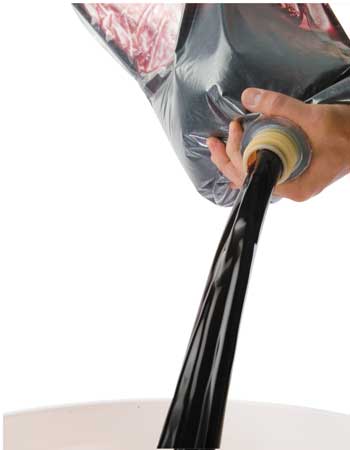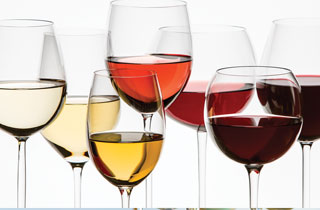 Most home winemakers are familiar with grape concentrates, whether they’ve used them in a “brew-on-premise” store or at home. What many people don’t know, however, is that concentrates are surprisingly versatile. Besides using concentrate as the sole basis for a batch of wine, you can also use it to supplement other wines and ingredients. Concentrates can add flavor, complexity, bouquet and fruitiness to your homemade wines.
Most home winemakers are familiar with grape concentrates, whether they’ve used them in a “brew-on-premise” store or at home. What many people don’t know, however, is that concentrates are surprisingly versatile. Besides using concentrate as the sole basis for a batch of wine, you can also use it to supplement other wines and ingredients. Concentrates can add flavor, complexity, bouquet and fruitiness to your homemade wines.
How Concentrates are Made
Concentrates are produced by first crushing and pressing the grapes, then — in the case of red grapes — extracting tannins, polyphenols and volatiles from the skins. This is often done by heating and adding the extract back into the juice, then evaporating the water content under high vacuum. The end product is a heavy syrup containing virtually everything in the original juice except the water.
This concentrate is treated with a pectin-destroying enzyme and sulphur dioxide, to prevent oxidation and bacterial infection. Then it’s sealed into cans or Mylar bags. The producer usually packages concentrate with a recipe, which most home winemakers follow with care. But if you can think (forgive the pun) “outside the box,” all kinds of interesting possibilities arise.
Since concentrates are just that — concentrated grape juice — they can be used not only to make a wine on their own, but also as an adjunct to other wines, whether it’s made from whole grapes, juice or berries. All you need to do is determine how much water to add to reconstitute the concentrate, and then do some measurements on acidity and specific gravity to ensure that the blend is in balance.
Concentrates vary, but a value of SG 1.390 is fairly typical (see the sidebar “A Mathematical Aside,” below). Such a concentrate contains about 20 percent of the original liquid content, but also proportionately more sugar and acid, and — in the case of reds — more tannin than the original.
Concentrate by itself will typically be about 80 degrees Brix with an acid content of about 2 percent (this is an average figure only — those containing juice and invert sugar will also vary). Adding 2.1 pints (1 L) of pure concentrate of SG 1.390 to another liquid will therefore add about 28 ounces (800 grams) of sugar and 6 ounces (200 mL) of liquid. This will also add about 20 grams of acid. Now we’re using concentrates as a source of sugar and acid, rather than using them as a complete winemaking ingredient alone.
Improving Grape Wines
Concentrates can be used to improve the outcome of a grape wine that lacks flavor or body, is low in sugar, or has an low level of acid due to less-than-optimum growing conditions. In these circumstances, the concentrate provides additional sugar and body, and can help to rescue an otherwise disappointing fresh-grape wine.
In my experience, blending a concentrate with quality fresh grapes — or even just grape skins — can produce wine with a fully commercial character, provided that the wine is treated as if it were made of fresh grapes only. In other words, you should punch the cap daily, and remove and press the skins after the desired period of contact. In addition, the grapes must be compatible with the wine. Concord grapes will not improve a Cabernet Sauvignon concentrate!
You’ll want to determine the sugar and acid content of the grape wine you are trying to improve, and then add concentrate to boost both of them. If you are cursed with a low-sugar, high-acid wine, concentrate will improve the sugar content but exacerbate the acid problem, and you will need to employ acid reduction to bring it into balance.
For example: Let’s say you find yourself with 5.2 gallons (20 L) of wine with a Brix of 20 (a total of 8.8 pounds or 4 kilograms of sugar) and an acid content of 5 parts per thousand, equal to 3.5 ounces (100 grams) of acid. Supplementing this wine with 2.1 pints (1 L) of concentrate at 80 degree Brix would add 28 ounces (800 grams) of sugar, 0.7 ounces (20 grams) of acid, and increase the volume to a bit less than 5.4 gallons (21 L), resulting in a final Brix of approximately 23 and an acid content of 5.7 parts per thousand. (These figures are obtained by adding the two amounts of sugar and acid, and dividing each by the new volume.)
We say “approximately” for the reasons outlined in our “mathematical aside” (see box): It’s important to use a hydrometer to measure sugar content of the adjusted must, and also test its acid level, due to variances in the sources (including concentrates) you may be using.
It is also possible to economize by producing a “second run,” using the skins from the pressing of a grape along with concentrate. After this batch, most of the flavors will have been extracted from the skins. In these cases, the approach is simply to make up the concentrate according to the original recipe and then add the skins to it.
Improving Non-Grape Wines
Your options are not limited to grape wines. Concentrates can improve the quality of wines made from other things as well, provided they’re not permitted to dominate the final character. Wines made from gooseberries, dandelions or rhubarb, for example, will benefit from the addition of white concentrates. Those made from red fruit, such as plums, will have added vinosity (the mouth-feel of a wine) when blended with red concentrates. The concentrate will replace some of the sugar and acid that would otherwise be needed.
In all cases, use a hydrometer to check sugar content and either a pH meter or titration to ensure the acid is correctly balanced. So-called “country wines,” made from ingredients other than grapes, almost always require sugar and acid adjustment.
Here’s an example. A recipe for dandelion wine reads as follows:
Step One: Use 7.5 pints (120 fluid ounces) of dandelion flowers (flower heads only), three pounds of sugar, two lemons, one orange, one pound of raisins, yeast and nutrient. Pour boiling water over the flowers and leave for three days.
Step Two: Add the other ingredients (using the juice only of the oranges and lemons). Make volume up to one gallon.
Step Three: After three days, strain out the flowers and raisins, then proceed as for any other wine.
When using concentrate, we can eliminate the sugar, the lemons and orange (which are used primarily for acidity) and the raisins (there for vinosity and tannin). Instead, at Step Two, add 3.7 pints (1-3/4 L) of white concentrate before making the volume up to one gallon. This will provide the requisite three pounds of sugar and 1.2 ounces (35 grams) of acid (equal to 0.28 ounce per 2.1 pint or eight grams per L), as well as vinosity. This will be a fairly strong wine, as many old recipes tend to be — the concentrate can be reduced to 2.6 pints (1 1/4 L) to better suit modern tastes.
If you’re making a sparkling wine and are aiming at an off-dry finish, you’ll be adding a “dosage” consisting of sugar, wine and stabilizer at final bottling. Why not try substituting a compatible concentrate for the sugar? It will add increased bouquet and fruitiness, and can be readily calculated. For every 3.5 ounces (100 grams) of sugar you would otherwise add, use 3.7 fluid ounces (125 mL) of concentrate instead. Dissolve it in the dosage wine, add stabilizer and proceed normally.
Bottom Line: Better Wine
Concentrates should not be viewed as an all-or-nothing proposition. Tinkering with the recipe by adding more or less water, sugar, acid or tannin can be a rewarding experience, provided you take the time to ensure that the sugar content and acid level of your must is correct. Replacing sugar with concentrate in other recipes will add flavor and complexity, as well as vinosity, to the finished product.
Adding concentrate to compatible fruit, whether grapes or garden fruit, allows you to expand your winemaking into areas that the commercial world is unable to match. Keeping good records will also allow you to repeat your successes and learn from your (hopefully) few disappointments.
Concentrates can have a greater role than you may have imagined — so smash the mold of paint-by-numbers winemaking!
A Mathematical Aside
Before WineMaker is flooded with letters from readers who have done the math — concluding that SG 1.400 equals 100 degrees Brix equals pure sugar, so 1.390 must be more than 80 percent sugar content, and that the numbers add up to more than 100 percent — it should be explained that the gravity of a must, or a concentrate, is not due solely to its sugar content. Some authorities calculate that between five and 10 percent of the gravity is due to other solids such as fruit particles, acids or salts.
In addition, acid content is not affected in a linear manner by dilution due to buffering and the actions of bitartrates. Finally, some of the elements are insoluble and add directly to volume, while others are soluble and have a lesser effect on final volume — for simplicity, we are also not accounting for the change in volume due to sugar dissolving in water. The use of average figures may not be correct in all cases, but is a reasonable rule of thumb — or, as we say in Canada, “close enough for government work.”
Good Blends
When blending concentrate with grapes (or juice), stay with pairs that are normally found in commercial wines.
• Cabernet Sauvignon and Cabernet Franc with Merlot
• Pinot Noir with Gamay
• Mourvedre, Syrah, Cinsault with Grenache
• Sauvignon Blanc with Sémillon
• Syrah, Marsanne (a white grape) with Viognier (also white)
• Auxerrois with Gamay







